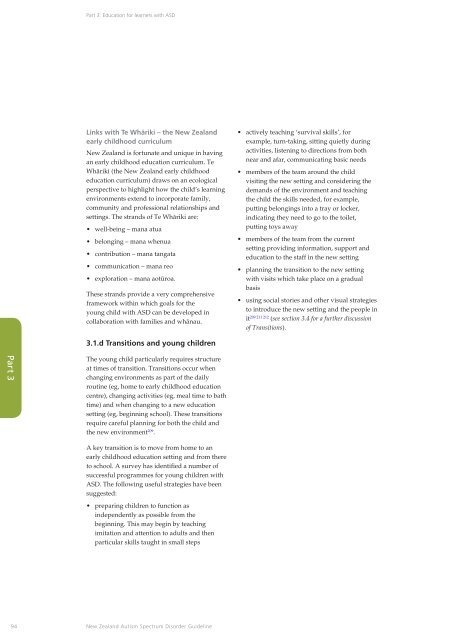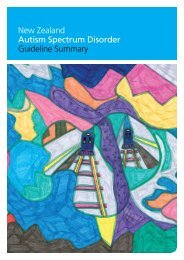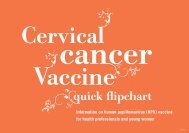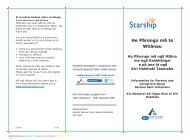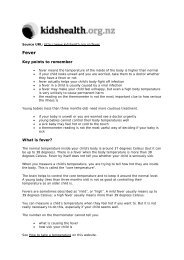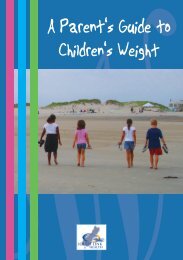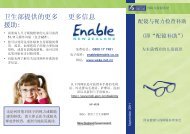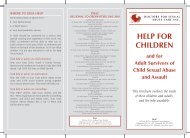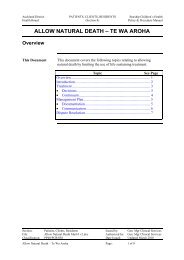New Zealand Autism Spectrum Disorder Guideline - Ministry of Health
New Zealand Autism Spectrum Disorder Guideline - Ministry of Health
New Zealand Autism Spectrum Disorder Guideline - Ministry of Health
You also want an ePaper? Increase the reach of your titles
YUMPU automatically turns print PDFs into web optimized ePapers that Google loves.
Part 3: Education for learners with ASD<br />
Links with Te Whäriki – the <strong>New</strong> <strong>Zealand</strong><br />
early childhood curriculum<br />
<strong>New</strong> <strong>Zealand</strong> is fortunate and unique in having<br />
an early childhood education curriculum. Te<br />
Whäriki (the <strong>New</strong> <strong>Zealand</strong> early childhood<br />
education curriculum) draws on an ecological<br />
perspective to highlight how the child’s learning<br />
environments extend to incorporate family,<br />
community and pr<strong>of</strong>essional relationships and<br />
settings. The strands <strong>of</strong> Te Whäriki are:<br />
• well-being – mana atua<br />
• belonging – mana whenua<br />
• contribution – mana tangata<br />
• communication – mana reo<br />
• exploration – mana aotüroa.<br />
These strands provide a very comprehensive<br />
framework within which goals for the<br />
young child with ASD can be developed in<br />
collaboration with families and whänau.<br />
• actively teaching ‘survival skills’, for<br />
example, turn-taking, sitting quietly during<br />
activities, listening to directions from both<br />
near and afar, communicating basic needs<br />
• members <strong>of</strong> the team around the child<br />
visiting the new setting and considering the<br />
demands <strong>of</strong> the environment and teaching<br />
the child the skills needed, for example,<br />
putting belongings into a tray or locker,<br />
indicating they need to go to the toilet,<br />
putting toys away<br />
• members <strong>of</strong> the team from the current<br />
setting providing information, support and<br />
education to the staff in the new setting<br />
• planning the transition to the new setting<br />
with visits which take place on a gradual<br />
basis<br />
• using social stories and other visual strategies<br />
to introduce the new setting and the people in<br />
it 209 211 212 (see section 3.4 for a further discussion<br />
<strong>of</strong> Transitions).<br />
3.1.d Transitions and young children<br />
Part 3<br />
The young child particularly requires structure<br />
at times <strong>of</strong> transition. Transitions occur when<br />
changing environments as part <strong>of</strong> the daily<br />
routine (eg, home to early childhood education<br />
centre), changing activities (eg, meal time to bath<br />
time) and when changing to a new education<br />
setting (eg, beginning school). These transitions<br />
require careful planning for both the child and<br />
the new environment 209 .<br />
A key transition is to move from home to an<br />
early childhood education setting and from there<br />
to school. A survey has identified a number <strong>of</strong><br />
successful programmes for young children with<br />
ASD. The following useful strategies have been<br />
suggested:<br />
• preparing children to function as<br />
independently as possible from the<br />
beginning. This may begin by teaching<br />
imitation and attention to adults and then<br />
particular skills taught in small steps<br />
94<br />
<strong>New</strong> <strong>Zealand</strong> <strong>Autism</strong> <strong>Spectrum</strong> <strong>Disorder</strong> <strong>Guideline</strong>


